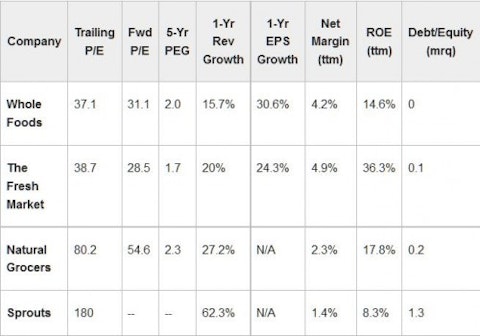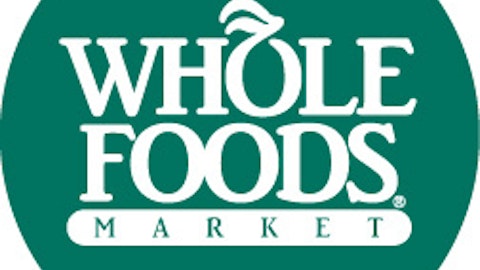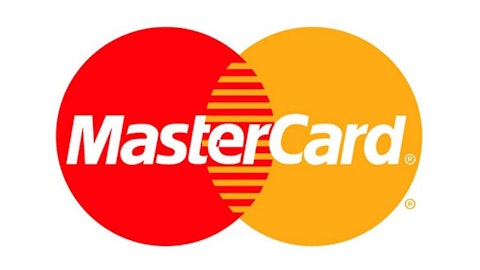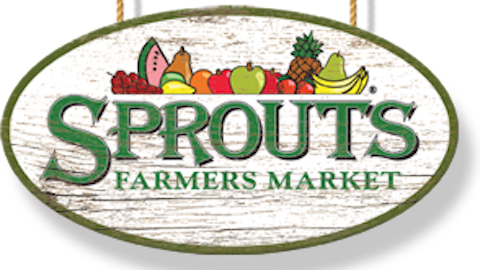Consumers have increasingly been gobbling up organic foods, driving U.S. sales from $11 billion in 2004 to $27 billion in 2012. Organic food sales grew at an annual rate of 7.4% in 2012, more than double the growth rate for all food sales. Given that organics account for less than 5% of overall grocery sales, there’s still plenty of growth potential left.
Since going public in 1992, first-mover Whole Foods Market, Inc. (NASDAQ:WFM), the largest retailer of natural and organic foods in the US, has been a huge beneficiary of this ongoing trend. Not surprisingly, an increasing number of retailers have been entering this space or going public in order to get a (bigger) piece of the growing organic pie.
It can be hard to keep track of who’s on first. So, here’s an overview of the main organic and natural food retailers.
Whole Foods Market, Inc. (NASDAQ:WFM)
Whole Foods Market, Inc. (NASDAQ:WFM) has 355 stores in the U.S., Canada, and the U.K, but it’s still in a considerable growth mode. It opened 25 new stores in fiscal 2012, and has already opened 24 new stores in its first three quarters of fiscal 2013. The company sees demand for 1,000 stores in the U.S. alone. It also sees growth opportunities in Canada and the U.K.
It’s often overlooked that Whole Foods Market, Inc. (NASDAQ:WFM) is also steadily becoming more of a food producer, as it offers a multitude of products under its “365” brand. A strong-selling private-label brand helps increase margins.
The Fresh Market Inc (NASDAQ:TFM)
The Fresh Market Inc (NASDAQ:TFM), based in North Carolina, is a specialty retailer providing fresh, high-quality foods focused on perishables. It went public in late 2010.
The company had 131 stores in 25 states as of April 28. The bulk (about 100) of its stores are located in the South, with a heavy concentration in Florida. It has a smaller presence in the Midwest and Northeast, and 2 stores in California.
For fiscal 2013, the company expects to open 19 to 22 stores, with 13 to 15 new stores opening in the second half of the year.
Natural Grocers by Vitamin Cottage Inc (NYSE:NGVC)
Natural Grocers by Vitamin Cottage Inc (NYSE:NGVC), based in Colorado, is a family-operated specialty retailer of natural and organic foods and dietary supplements. It went public in July 2012.
The company has 70 stores in 13 states. Stores are concentrated in the Midwest, Mountain States, and West. It opened 13 stores in fiscal 2013, and already has plans to open at least 11 in fiscal 2014.
Sprouts Farmers Market Inc (NASDAQ:SFM)
Sprouts Farmers Market Inc (NASDAQ:SFM), based in Phoenix, AZ, is a retailer of natural and organic foods. It just went public on Aug. 1, with its stock price quickly doubling, likely suggesting both organic food is an attractive space and the market’s over-heated.
It had 160 stores in eight states as of July 6. Stores are concentrated in the Mountain States, Southwest, Oklahoma, and Texas. It will open 19 stores this year and plans to open 20 stores in 2014.
How do the players stack up by the numbers?

Sources: Yahoo! Finance & Morningstar; annual numbers are for last full fiscal year; data to Aug. 15.
Whole Foods Market, Inc. (NASDAQ:WFM) and The Fresh Market Inc (NASDAQ:TFM) are the standouts. The Fresh Market has outstanding ROE, while Whole Foods’ and the Natural Grocers by Vitamin Cottage Inc (NYSE:NGVC)’ are solid. The Fresh Market Inc (NASDAQ:TFM) and Whole Foods are the runaway winners on profit margin.
Sprouts needs to sprout better margins before I’d consider it. We’d expect better margins for companies involved in the natural and organic niche. Additionally, its triple-digit P/E suggests it’s over-priced.
Whole Foods reported fiscal third quarter results on July 31. It had a solid quarter, with revenue and EPS up 12.1% and 20.2%, respectively. Comparable store sales were up 7.5%, which is tops in this industry, yet down from 8.2% in the prior-year quarter.
It upped EPS guidance for 2013 and now expects EPS growth of 17% to 18% on sales growth of about 13%. Analysts’ estimates are for 18.9% average EPS growth over the next five years.




